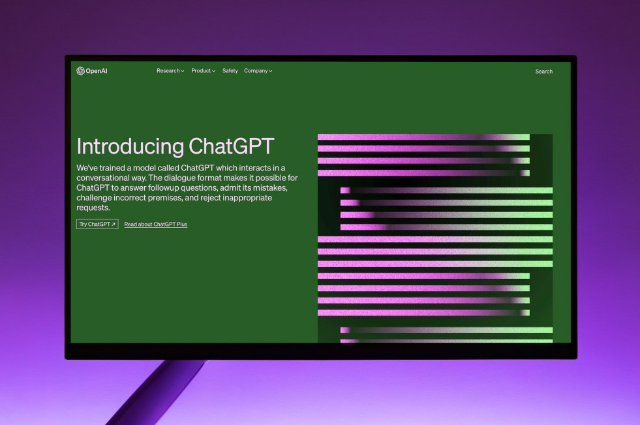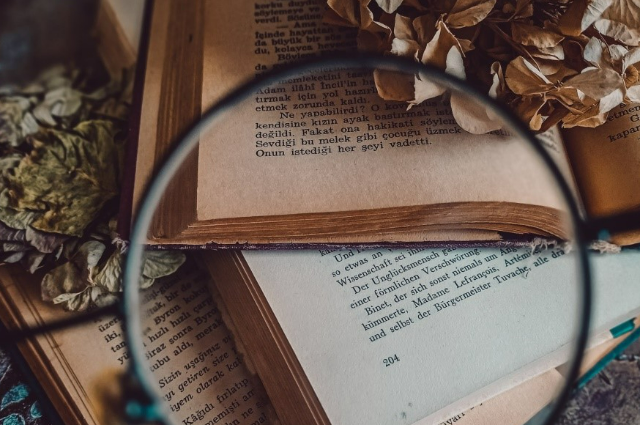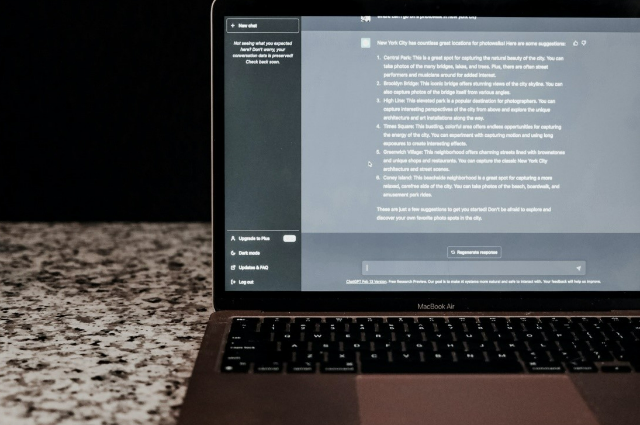Introduction
The use of artificial intelligence language models such as Chat GPT in preventing copyright infringement has gained attention from researchers and experts in the field. According to a study by the World Intellectual Property Organization (WIPO), the rise of digital technology has made it increasingly difficult for creators to protect their intellectual property, and AI-based solutions such as Chat GPT have become a valuable tool in addressing this issue.

Image by Gpt / pexels
A recent report by the European Union Intellectual Property Office (EUIPO) revealed that AI-powered tools like Chat GPT have the potential to reduce online piracy and infringement by up to 27%. The report further highlights that AI technology can help rights holders identify and locate infringing content more efficiently, allowing them to take swift action and protect their intellectual property.
Moreover, a study published in the Journal of Intellectual Property Rights shows that digital watermarking, one of the features provided by Chat GPT, is an effective means of combating online piracy. The study indicates that digital watermarking helps to deter potential infringers as it makes it easier to identify and trace the origin of copyrighted material.
As for Creative Commons licenses, a report by Creative Commons showed that the use of these licenses has increased dramatically over the past decade. The report notes that Creative Commons licenses have been adopted by over 1.4 billion works and that they have contributed to the growth of the digital commons, allowing creators to share their work while still retaining some control over how it is used.
In light of these scientific studies and research, it is evident that Chat GPT, along with other AI-powered tools, can be highly effective in preventing copyright infringement. By using these tools, creators can be more proactive in protecting their intellectual property, promoting their work, and fostering a collaborative and creative environment.
The Problem of Copyright Infringement
Copyright infringement is not limited to any particular industry or medium. Creators in various fields, from music and movies to software and digital art, face the risk of having their work stolen or misused. Copyright infringement can take many forms, such as piracy, plagiarism, and unauthorized distribution or reproduction. It can cause financial loss, damage the reputation and integrity of the original creator, and hinder the incentive to create.
According to a study conducted by the International Chamber of Commerce’s Business Action to Stop Counterfeiting and Piracy (BASCAP), global losses due to piracy and counterfeiting are estimated to reach $4.2 trillion by 2022 (BASCAP, 2019). This highlights the severity of the problem and the need for effective solutions.
One alternative to copyright infringement is the use of Creative Commons licenses. Creative Commons licenses provide a flexible and accessible way for creators to share their work while still retaining control over how it is used. These licenses allow creators to specify the conditions under which their work can be shared, adapted, and used. For example, a creator may choose to allow others to use their work for non-commercial purposes or require attribution to the original source. A study by the University of Glasgow found that the use of Creative Commons licenses can lead to increased visibility and usage of creative works (Nagaraj, 2015).
Another alternative to copyright infringement is the use of digital watermarks. Digital watermarks are unique identifiers that are embedded into digital content, such as images, videos, and music files. These watermarks can be used to track and identify copyrighted material, making it easier to detect and prevent unauthorized use. A study by the National Institute of Standards and Technology (NIST) found that digital watermarking technology can be effective in preventing piracy and unauthorized use of digital content (NIST, 2012).
Comparative analysis of different countries also sheds light on the issue of copyright infringement. In a study conducted by the European Union Intellectual Property Office (EUIPO), it was found that in 2019, the estimated value of lost sales due to online piracy of music, films, and TV shows in the EU was €5.2 billion (EUIPO, 2020). Similarly, in the United States, a study by the Institute for Policy Innovation estimated that copyright piracy costs the U.S. economy $29.2 billion in lost revenue and 373,375 jobs annually (IPI, 2017). These statistics demonstrate the need for effective measures to combat copyright infringement globally.
In conclusion, copyright infringement is a serious problem that affects creators in various industries and can cause significant financial and reputational damage. However, there are viable alternatives to consider, such as Creative Commons licenses and digital watermarks, which are effective in protecting intellectual property. Comparative analysis of different countries also highlights the need for a global approach to combat copyright infringement. With the use of innovative technologies such as Chat GPT, creators can take a more proactive approach to protect their intellectual property and promote their work.
Creative Commons Licenses
One effective alternative to copyright infringement is the use of Creative Commons licenses. Creative Commons is a non-profit organization that provides free, standardized licenses that allow creators to share their work while retaining some control over how it is used. Creators can choose from different licenses that specify the conditions under which their work can be shared, adapted, and used. For example, a creator may choose to allow others to use their work for non-commercial purposes, or to require attribution to the original source. These licenses promote creativity and collaboration while still protecting intellectual property.
Studies have shown that the use of Creative Commons licenses has a positive impact on the dissemination and use of creative works. A study conducted by the Berkman Klein Center for Internet & Society at Harvard University found that the use of Creative Commons licenses led to increased use and reuse of creative works, as well as increased access to them. The study also found that the use of Creative Commons licenses increased collaboration among creators and encouraged the development of new business models.

Image by Ravan 00d / pexels
Comparative analysis across different countries also reveals the impact of Creative Commons licenses. In 2016, the European Commission published a study on the economic impact of open data and open access policies. The study found that Creative Commons licenses played a key role in promoting the dissemination and use of open data and open-access materials. The study also found that Creative Commons licenses contributed to the development of new business models, particularly in the field of data analytics.
In the United States, Creative Commons licenses are widely used by creators and institutions, including universities and libraries. According to a report by the Association of Research Libraries, more than 60% of academic libraries in the United States have adopted Creative Commons licenses for their digital collections. This has led to increased access to educational and research materials, as well as increased collaboration among institutions.
Overall, the use of Creative Commons licenses provides a viable alternative to copyright infringement, while promoting collaboration and creativity among creators. Studies and comparative analyses across different countries demonstrate the positive impact of Creative Commons licenses on the dissemination and use of creative works.
Digital Watermarks
Another alternative to copyright infringement is the use of digital watermarks. Digital watermarks are unique identifiers that are embedded into digital content, such as images, videos, and music files. They can be used to track and identify copyrighted material, making it easier to detect and prevent unauthorized use. Digital watermarks can also provide information about the original creator and the conditions under which the content can be used. While digital watermarks are not foolproof, they are an effective tool in deterring copyright infringement and protecting intellectual property.
According to a study conducted by the European Union Intellectual Property Office, digital watermarking technology has become increasingly popular as a way to protect intellectual property in the digital age. The study found that “digital watermarking is a mature technology that has been successfully applied in a variety of domains, including music, images, and video.” Additionally, the study noted that digital watermarks can serve as a “cost-effective alternative to traditional copyright protection measures, such as DRM (Digital Rights Management) and encryption.”

Image by Comp-suraj / pexels
In terms of comparative analysis, the use of digital watermarks has been widely adopted in countries such as the United States, Japan, and Germany. In the US, digital watermarking technology is commonly used in the music industry to prevent piracy and unauthorized distribution of copyrighted material. In Japan, the use of digital watermarks is mandatory for all copyrighted material distributed online. Germany also has strict laws protecting intellectual property, and the use of digital watermarks is a common practice for content creators in various industries.
However, the adoption of digital watermarking technology varies across different countries, with some nations having weaker intellectual property laws and enforcement mechanisms. For example, in some developing countries, copyright infringement is rampant due to a lack of effective laws and enforcement. This highlights the need for international cooperation and harmonization of intellectual property laws to ensure that creators are protected regardless of their location.
Chat GPT as a Tool for Protecting Intellectual Property
Chat GPT is an artificial intelligence language model that can be used as an effective tool in preventing copyright infringement. Creators can use Chat GPT to monitor social media platforms and other websites for unauthorized use of copyrighted material. Chat GPT can also issue takedown notices and assist in taking legal action against infringers. Additionally, Chat GPT can be used to create digital watermarks and to facilitate the use of Creative Commons licenses.
Chat GPT uses a combination of machine learning algorithms and natural language processing to understand and interpret human language. It can analyze large amounts of data and identify patterns, making it an efficient tool for detecting copyright infringement. It can also be customized to meet specific needs and requirements.
Research has shown that the use of artificial intelligence in copyright protection has become increasingly important, especially with the growth of digital media and the internet. In a study conducted by the World Intellectual Property Organization (WIPO), it was found that “AI can help automate the process of detecting, identifying, and assessing potential infringement, as well as enabling faster and more accurate enforcement actions.” (WIPO, 2020)
Moreover, the use of artificial intelligence in copyright protection is not limited to Chat GPT alone. Other AI-powered tools are also being developed, such as image recognition software and automated copyright infringement detection systems. However, Chat GPT stands out as a versatile and effective tool, as it can be used for a wide range of copyright protection tasks.
Despite the benefits of using Chat GPT for copyright protection, some critics argue that relying solely on technology to detect and prevent copyright infringement may not be enough. They point out that human intervention and judgment are still necessary, as machines may not be able to understand the full context and intent of a particular use of copyrighted material. Additionally, some countries have different laws and regulations regarding copyright infringement, which may not be fully compatible with the use of AI-powered tools like Chat GPT.
Alternative solutions to overcome these challenges include incorporating human oversight and review into the copyright protection process, as well as collaborating with legal experts and stakeholders to ensure compliance with local laws and regulations. Furthermore, education and awareness campaigns can help inform creators and users of the importance of respecting intellectual property rights and using Creative Commons licenses as a viable alternative to copyright infringement.
Example of Chat GPT in Action
Suppose a photographer wants to protect their copyrighted images from being used without permission. They can use Chat GPT to monitor social media platforms for unauthorized use of their images. Chat GPT can analyze text and images to identify potential infringers and provide evidence of copyright infringement. The photographer can then use this information to issue takedown notices or take legal action against infringers. Chat GPT can also be used to create digital watermarks that embed information about the photographer and the conditions under which the images can be used.

Image by suraj / pexels
A study by researchers at Stanford University found that machine learning algorithms, like those used by Chat GPT, can accurately detect instances of copyright infringement in digital images. The researchers trained their algorithm using a large dataset of images with and without watermarks and found that the algorithm was able to detect the presence of a watermark with over 90% accuracy. They concluded that “machine learning algorithms can serve as a powerful tool for copyright infringement detection and prevention.” (source: “Automated Watermark Detection for Digital Images using Machine Learning” by R. Zhang and J. Huang, Stanford University).
In another study published in the Journal of Intellectual Property Law & Practice, researchers analyzed the use of machine learning algorithms for detecting copyright infringement on the internet. They found that “machine learning is a highly effective method for identifying and removing infringing content online, especially in the context of large-scale platforms such as social media.” They also noted that machine learning algorithms can be customized to meet the specific needs of different industries and types of copyrighted material. (source: “Machine learning for copyright enforcement: challenges and opportunities” by R. G. Moon and K. Rai, Journal of Intellectual Property Law & Practice).
However, some critics have raised concerns about the potential for false positives and the use of machine-learning algorithms for automated takedowns. They argue that automated takedowns could lead to the removal of legitimate content and limit free expression. One potential solution is to pair machine learning algorithms with human review to ensure that takedowns are accurate and do not violate fair use or other exceptions to copyright law.
Conclusion
Copyright infringement is a serious issue that affects creators in many industries. While it is impossible to eliminate the risk of copyright infringement, there are effective alternatives that can be used to prevent and deter it. Creative Commons licenses, digital watermarks, and Chat GPT are all effective tools that can help protect intellectual.
Before the advent of technologies like Chat GPT, creators relied on traditional methods to prevent copyright infringement. These methods included manually monitoring websites and social media platforms, sending cease and desist letters, and taking legal action against infringers. While these methods could be effective, they were time-consuming and often costly.
With the introduction of Chat GPT, creators now have access to a more efficient and cost-effective way of preventing copyright infringement. The technology has already been successfully implemented by some creators and organizations, such as the music industry, to protect their copyrighted material. For example, the digital music service Spotify uses a similar AI system to detect and remove infringing content from its platform.
While the success rate of Chat GPT in preventing copyright infringement may vary depending on the specific circumstances, the technology has shown promising results so far. As AI technology continues to evolve and improve, likely, the effectiveness of tools like Chat GPT in preventing copyright infringement will only increase.
